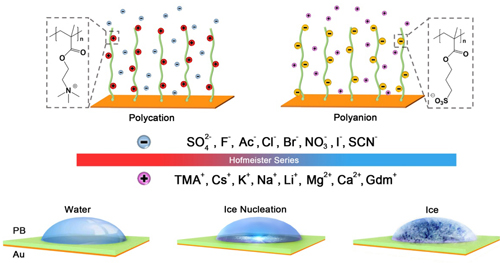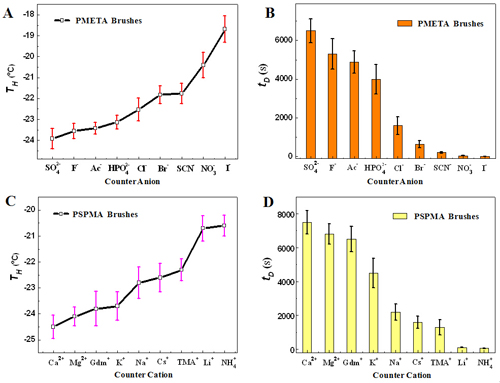Ice formation is ubiquitous and crucial in many fields such as cryobiology, geology and climate science. It is believed that the molecular level understanding of on ice formation is essential to predict the future of our planet. Ions are often involved in the process of ice formation. Particular interests have been focused on ice nucleation, because it is the initial and rate-limiting step for ice formation. In real systems, however, ice nucleation occurs more often on foreign surfaces, i.e., via heterogeneous ice nucleation (HIN). It is highly desirable to investigate the effect of ions on HIN.
Recently, a research group at Institute of Chemistry, the Chinese Academy of Sciences (ICCAS) headed by Prof. WANG Jianjun reported that the effect of ions on HIN on the polyelectrolyte brush (PB) surface by simply exchanging the counterions. For the first time they discovered the distinct efficiency of ions in tuning HIN. Moreover, a large heterogeneous ice nucleation temperature window up to 7.8 oC was demonstrated. By establishing a correlation between the fraction of ice-like water molecules and kinetics of structural transformation from liquid-like to ice-like water molecules at the PB/water interface with different counterions, the molecular dynamics (MD) simulation analysis carried out by their co-workers was consistent with the experimental observation of the ion-specific effect on HIN. Their findings not only shed new light on the ion-specific effect on ice nucleation but also can stimulate future studies involving design of anti-icing material. The physical principle behind the work will further motivate the ongoing interest in exploring origins of Hofmeister effects.
This work was carried out in collaboration with Prof. GAO Yiqin's group in Peking University, and was recently published in Science Advances.

Illustration of heterogeneous ice nucleation on cationic and anionic polyelectrolyte brush surfaces with different counterions. (Image by Prof. WANG Jian-Jun)

Distinct efficiency of anions and cations in tuning heterogeneous ice nucleation (HIN) follows the Hofmeister series. (Image by Prof. WANG Jian-Jun)
Prof. WANG Jianjun
Laboratory of Green Printing, Institute of Chemistry, Chinese Academy of Sciences,
Email: wangj220@iccas.ac.cn
